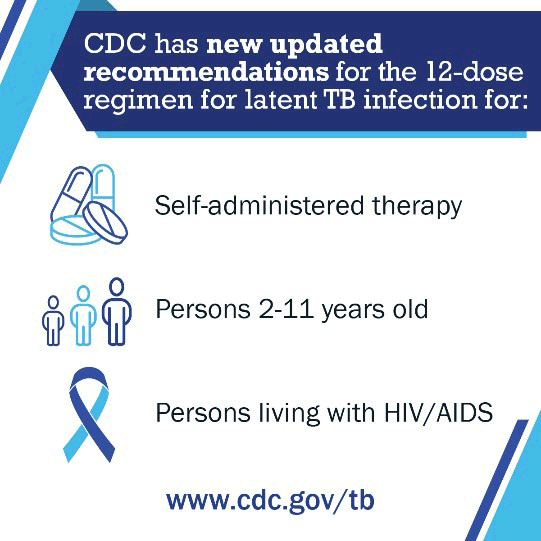Latent TB Infection and HIV? CDC Has Updated Recommendations
Topics

The Centers for Disease Control and Prevention (CDC) released updated recommendations for use of once-weekly isoniazid-rifapentine for 12 weeks (3HP) for treatment of latent tuberculosis (TB) infection. The updated recommendations, published in CDC’s Morbidity and Mortality Weekly Report (MMWR), support expanded use of an effective, shorter treatment regimen to reach even more people with latent TB infection, including people with HIV/AIDS.
The updated recommendations include the use of 3HP:
- By directly observed therapy or self-administered therapy in persons over 2 years of age,
- In persons who are living with HIV/AIDS and taking antiretroviral medications with acceptable drug interactions with rifapentine, and
- In children and adolescents, 2-11 years old.
These updated recommendations are very good news for those with HIV and latent TB infection. Because HIV infection weakens the immune system, people with latent TB infection and HIV infection are at very high risk of developing TB disease, if not treated. Previously, CDC only recommended the 3HP regimen for treatment of latent TB infection in people with HIV who were otherwise healthy and not taking antiretroviral medication. At that time, we did not know enough about the interactions between rifapentine and certain antiviral medications. New data now show an absence of clinically significant drug interactions between once-weekly rifapentine and the antiviral medications efavirenz and raltegravir.
Healthcare providers treating patients with HIV infection and latent TB infection can find information about interactions between rifamycins (including rifapentine) and antiretrovirals in the Department of Health and Human Services’ Guidelines for the Use of Antiretroviral Agents in HIV-1-Infected Adults and Adolescents, as well as useful tables with information on other drug interactions. For those patients on antiretroviral agents, healthcare providers should consult with experts in TB and HIV management to determine the best overall treatment regimen.
The 3HP regimen is the shortest of several regimens available to treat latent TB infection today and can remove barriers to initiate and complete treatment. A shorter treatment timeframe, the option for self-administration, and reduced costs all contribute to increasing the number of people who complete treatment for latent TB infection, helping to prevent future cases of TB disease.
We all play an important role in TB prevention. We encourage clinicians and public health professionals to review and implement the updated recommendations, which include guidance on patient education and monitoring, and to visit the LTBI resource page for additional resources on latent TB infection.